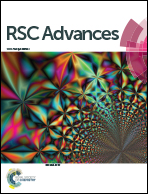Graphene-intercalated Fe2O3/TiO2 heterojunctions for efficient photoelectrolysis of water†
Abstract
Interfacial modification of α-Fe2O3/TiO2 multilayer photoanodes by intercalating few-layer graphene (FLG) was found to improve water splitting efficiency due to superior transport properties, when compared to individual iron and titanium oxides and heterojunctions thereof. Both metal oxides and graphene sheets were grown by plasma-enhanced chemical vapor deposition. Compared to the onset potential achieved for α-Fe2O3 films (1 V vs. RHE), the α-Fe2O3/TiO2 bilayer structure yielded a better onset potential (0.3 V vs. RHE). Heterojunctioned bilayers exhibited a higher photocurrent density (0.32 mA cm−2 at 1.23 V vs. RHE) than the single α-Fe2O3 layer (0.22 mA cm−2 at 1.23 V vs. RHE), indicating more efficient light harvesting and higher concentration of photogenerated charge carriers. For more efficient charge transport at the interface, a few layer graphene sheet was intercalated into the α-Fe2O3/TiO2 interface, which substantially increased the photocurrent density to 0.85 mA cm−2 (1.23 V vs. RHE) and shifted the onset potential (0.25 V vs. RHE). Ultrafast transient absorption spectroscopy studies indicated that the incorporation of FLG between the α-Fe2O3 and TiO2 layers resulted in reduced recombination in the α-Fe2O3 layer. The results showed that graphene intercalation improved the charge separation and the photocurrent density of the FTO/α-Fe2O3/FLG/TiO2 system.


 Please wait while we load your content...
Please wait while we load your content...